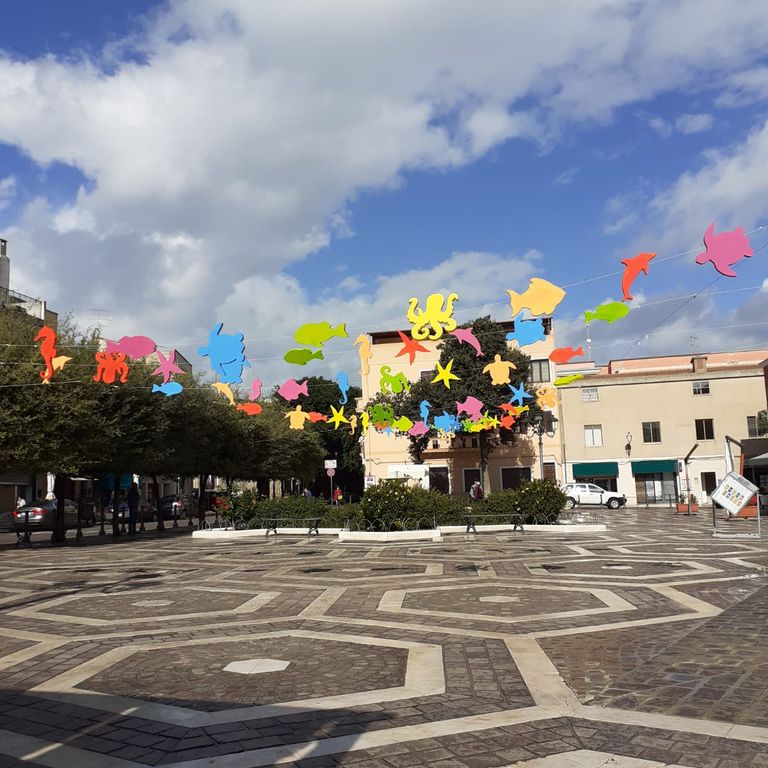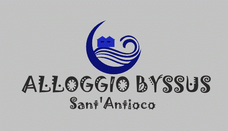Sant'Antioco ....... Sulki
Autour de Cala Sapone

Via AZUNI
SITUATION DE SANT’ANTIOCO
L’île de Sant’Antioco possède deux ports , Sant’Antioco et La Calasetta.
Le premier à l’est et le second au nord.
On arrive sur l’île directement à Sant’Antioco.
C’est une commune d'environ 11300 habitants qui se dresse sur le superbe golfe de Palmas.
Le port de plaisance, avec ses édifices colorés, donnent à la ville cette atmosphère maritime qui la caractérise tant.
Ses ruelles romantiques et de délicieux petits restaurants enivrent l’air de parfums invitants.
SITUATION DE L' APPARTEMENT DANS LA VILLE
Il se situe via Toscana, dans cette rue à sens unique à 8mn à pied de la piazza italia (plein centre ville),à même distance de la marina, ainsi que de la place du marché (qui est le mardi matin).
Dans la rue se trouve une pizzeria de vente à emporter, une boulangerie et une supérette.
Vous avez deux supermarchés à proximité (350 et 600m).
POUR VOUS Y RENDRE
Si vous arrivez par avion, l'aéroport de Cagliari est le plus proche ( 80km).
Si vous arrivez par ferry, cela peut être Porto Torres au nord ouest ( 275km) ou le Golfe d’Aranci au nord est ( 335km).

Piazza Italia
SITUAZIONE DI SANT'ANTIOCO
L'isola di Sant'Antioco ha due porti , Sant'Antioco e La Calasetta.
Il primo a est e il secondo a nord. Arriviamo sull'isola direttamente a Sant'Antioco.
È un comune di circa 11.300 abitanti che sorge sullo splendido Golfo di Palmas.
Il porto turistico, con i suoi palazzi colorati, dona alla città quell'atmosfera marinara che tanto la caratterizza.
i suoi romantici vicoli e deliziosi ristorantini inebriano l'aria di profumi invitanti.
SITUAZIONE DELL'APPARTAMENTO IN CITTÀ
Si trova in via Toscana, in questa strada a senso unico a 8 minuti a piedi da piazza italia (pieno centro città), alla stessa distanza dal porto turistico, nonché dalla piazza del mercato (que é martedi mattina).
Dall'altra parte della strada c'è una pizzeria da asporto, un panificio e un minimarket.
Ci sono due supermercati nelle vicinanze (350 e 600 m).
PER ARRIVARE
Se arrivate in aereo, l'aeroporto di Cagliari è il più vicino (80km).
Se arrivate in traghetto, potrebbe essere Porto Torres a nord-ovest (275 km) o il Golfo degli Aranci a nord-est (335 km)

laguna di Sant' Antioco
SITUATION OF SANT’ANTIOCOO
SITUATION OF SANT’ANTIOCOO
The island of Sant'Antioco has two ports , Sant'Antioco and La Calasetta.
The first in the east and the second in the north. We arrive on the island directly in Sant’Antioco.
It is a town of about 11,300 inhabitants that sits on the beautiful Gulf of Palmas.
The marina, with its colorful buildings, gives the city that maritime atmosphere that characterizes it so much.
Its romantic alleys and delicious little restaurants intoxicate the air with inviting scents.
SITUATION OF THE APARTMENT IN THE CITY
It is located via Toscana, in this one-way street 8 minutes walk from piazza italia (full city center), at the same distance from the marina, as well as from the market square( which is tuesday morning).
Across the street is a take-out pizzeria, bakery and mini-market.
You have two supermarkets nearby (350 and 600m)
TO GET THERE
If you arrive by plane, Cagliari airport is the closest (80km).
If you arrive by ferry, it could be Porto Torres in the northwest (275km) or the Gulf of Aranci in the northeast (335km).

Le tophet
UN PEU D’HISTOIRE
Aujourd’hui séparée de la Sardaigne par un étroit chenal, Sant’Antioco fut rattachée à l’île par les phéniciens, qui pour créer un isthme artificiel, durent bâtir une étroite bande de terre longue de 3km.
Le pont qui relie désormais la Sardaigne à Sant’Antioco surplombe les ruines de l’ancien pont romain.
L’île tient son nom actuel de saint Antiochus qui y fut martyrisé sous le règne d’Adrien (II s. apr. J-C) pour avoir refusé de renier sa foi.
Sa statue est portée en procession à travers les rues de la ville 15 jours après Pâques, le 1er Août et le 13 Novembre.
Autrefois connue sous le nom de Sulky ou Sulcis, Sant’Antioco commença à être habitée en 770 avant J-C pour ensuite connaître une période d’épanouissement avec les romains qui en firent, aux côté de Karalis ( Cagliari), la ville la plus prospère de Sardaigne.
Du port de commerce florissant de l’époque romaine, il ne reste que la fontaine aujourd’hui souterraine de la piazza italia, les vestiges d’un mausolée en pierre d’époque républicaine sur la via Eléonora d’Arborea et ceux du pont romain (Pontimannu) aux abords du chenal.

Catacombes
UN PO 'DI STORIA
UN PO 'DI STORIA
Separata oggi dalla Sardegna da uno stretto canale, Sant'Antioco fu attaccata all'isola dai Fenici, che per creare un istmo artificiale, dovettero costruire una stretta striscia di terra lunga 3 km.
Il ponte che ora collega la Sardegna a Sant'Antioco si affaccia sui ruderi dell'antico ponte romano.
L'isola prende il nome attuale da Sant'Antioco, che vi fu martirizzato durante il regno di Adriano (II secolo dC) per essersi rifiutato di rinnegare la sua fede, la sua statua viene portata in processione per le vie della città. giorni dopo Pasqua, 1 agosto e 13 novembre.
Anticamente nota come Sulky o Sulcis, Sant'Antioco iniziò ad essere abitata nel 770 a.C. e poi conobbe un periodo di fiorente con i Romani che ne fecero, insieme a Karalis (Cagliari), la città più florida di Sardegna.
Del fiorente porto commerciale di epoca romana rimangono solo l'ormai sotterranea fontana di Piazza Italia, i resti di un mausoleo in pietra di epoca repubblicana su via Eléonora d'Arborea e quelli del ponte romano. (Pontimannu) nei pressi del canale.

Fontaine
A LITTLE HISTORY
Now separated from Sardinia by a narrow channel, Sant'Antioco was attached to the island by the Phoenicians, who to create an artificial isthmus, had to build a narrow strip of land 3 km long.
The bridge that now connects Sardinia to Sant'Antioco overlooks the ruins of the ancient Roman bridge.
The island takes its current name from Saint Antiochus, who was martyred there during the reign of Adrian (2nd century AD) for refusing to deny his faith, and his statue is carried in procession through the streets of the city. days after Easter, August 1 and November 13.
Formerly known as Sulky or Sulcis, Sant'Antioco began to be inhabited in 770 BC and then experienced a period of flourishing with the Romans who made it, alongside Karalis (Cagliari), the most prosperous city of Sardinia.
Of the flourishing commercial port of Roman times, only the now underground fountain of Piazza Italia, the remains of a stone mausoleum from the Republican period on Via Eléonora d'Arborea and those of the Roman bridge remain. (Pontimannu) near the channel.
Nous avons besoin de votre consentement pour charger les traductions
Nous utilisons un service tiers pour traduire le contenu du site web qui peut collecter des données sur votre activité. Veuillez consulter les détails dans la politique de confidentialité et accepter le service pour voir les traductions.

